Recent gallery offerings indicate a preponderance of attention is still granted to painters who fit within a spectrum that spreads between pure abstraction and an abstraction that flirts with readable imagery. Stand Brice Marden on one side and Amy Sillman on the other and you get the idea.
Still largely hidden—with the exception of a few exhibitions including “Steven Assael: New Paintings and Drawings” at the Forum Gallery—are the painters who choose to struggle with the many variations possible within older motifs, the so-called representational painters.
Representational painters are by market choice—a choice echoed, whether they care to admit it or not, by the curatorial interests of many contemporary art museums —seen as occupying a fringe of contemporary painting. Perhaps this is an improvement over the days when Edward Hopper was understood, albeit respectfully, as occupying a condemned building, waiting for developers to move him out in order to construct something new.
Today, as so many abstract painters inch closer to an overt inclusion of recognizable imagery, fully invested representational painters are no longer just filling out the far end of the painting spectrum, but are playing a key, if yet unappreciated role in reunifying the entire painterly enterprise.
As late critical constructs like “provisional painting” show that theorists seem capable of doing little more than explaining the desperation of those who have lost their way, it becomes clear that a painterly revisiting of subject matter is where the real energy lies. How subject matter is shared between an artist and a viewer is what ought to draw our attention these days.
And among painters open to the possibilities inherent in a revisiting of visually explored subject matter, the most ambitious are those like Steven Assael; painters who are willing to risk addressing our residual modernist discomfort with symbols, allegory and drama, all those elements that were abandoned in the formalist experiments of the last century though successfully revived in other art forms, notably film, fiction and theater.
The theme of Assael’s current solo show at Forum Gallery is the bride, a subject of universal familiarity and one he avoids steering with the usual nods and winks in the direction of Duchamp’s tired old conjugal witticisms. Instead viewers get a highly personal vision in the form of rather unsettling bridal portraits. Based on a common though culturally loaded image, there is a teasingly ambiguous tone to what initially appears to be a strictly unified series.
.
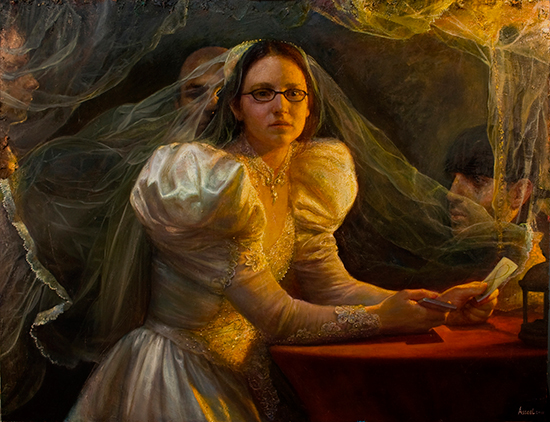
"Bride with Cards" by Steven Assael, 2011. oil on canvas, 36 3/8 x 48 inches. © Steven Assael, Courtesy of Forum Gallery, New York
.
True, each canvas shares the same dark, romantic gloom that Assael is known for, which he creates by raking an amber light across an umber Baroque murkiness. But figures are placed in oddly staged arrangements. Some of the brides wear elaborate satin gowns, others are nude; most are attended either by partially visible assistants or fully developed figures who share a congested space with them.
.
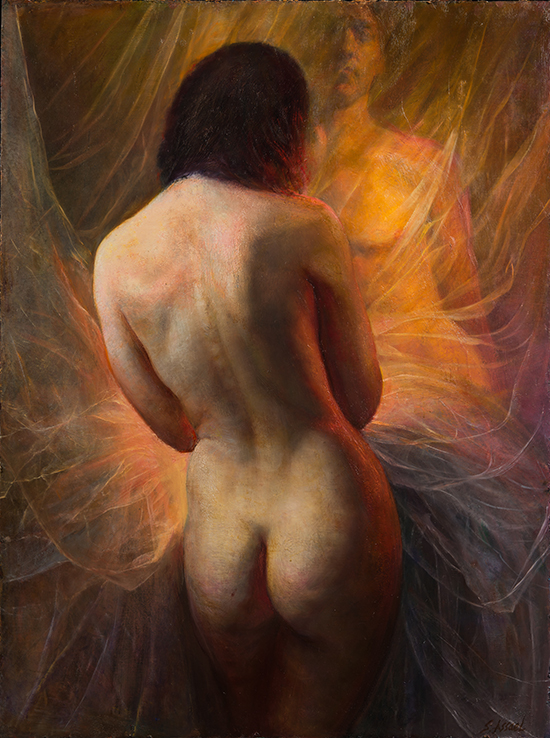
"In Front and Behind the Veil" by Steven Assael, 2014. Oil on canvas, 48 x 36 inches. © Steven Assael, Courtesy of Forum Gallery, New York.
.
Bride with a Lantern is a frontal image of an ambivalent looking young woman, suffering, one might say, the formal swathe of a white bridal gown and surrounded by an elaborate veil held aloft by arms and hands of otherwise invisible helpers. The veil motif appears in many of the canvases, the texture of which Assael executes with consistent finesse. Stepping back, the viewer discovers that this billowing crinoline cloud takes on a sinister, near skull-like appearance against the dark background.
.

"Bride with Lantern" by Steven Assael, 2015. Oil on canvas, 72 x 60 inches. © Steven Assael, Courtesy of Forum Gallery, New York.
.
Typical to a point, the bride steps out of character with an odd sideways look, characterized by a deadpan stare that lies somewhere between resignation and a scowl that would prevent a pick-up line from ever leaving the safety of a suitor’s lips, and, worse, chill the will of a nervous groom.
The lantern referenced in the title is a metallic affair she holds with both her hands, hanging its warm yellow triangle of light precisely at the threshold of her birth canal. Pomp and circumstance are noted. Formality is clearly indicated. Yet this girl is not a happy camper. Her demeanor, along with an ambient light reminiscent of a basement’s diffused shadow, gives an acrid tone to the picture.
Several other canvases in the show depict young women in all manner of bridal accoutrement. Apiim is again a single figure in an elaborate gown, frontally composed, also facing the viewer passively. If there is anything consistent in these bride images, it is a pronounced passivity. Seated this time, she holds what appears to be a smart phone on her lap. More than any other symbol Assael puts to use in these paintings, her grasp of this ubiquitous contemporary item is one of the most ordinary and lighthearted touches in the series. It seems to make a harmless reference to the dizzying array of interested parties, both commercial and familial that vie for a bride’s attention.
.
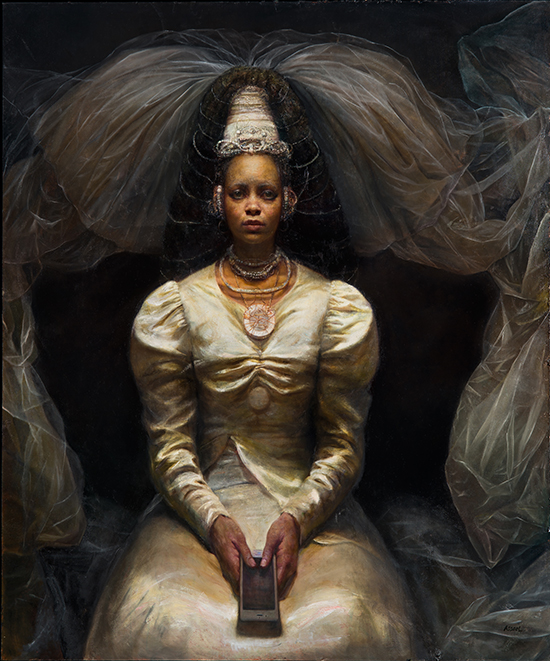
"Apiim" by Steven Assael, 2015. Oil on canvas, 72 x 60 inches. © Steven Assael, Courtesy of Forum Gallery, New York.
.
Bridal Preparation is more overtly allegorical. In it a disinterested figure of a nude young woman stands and faces the viewer as an older women sits across from her at an angle. Both are apparently participating in a gown-fitting session, with a few unexplained heads looking on from behind. Unlike a straightforward illustration of a group event, the action has paused and the figures hold their pose, assumingly for the benefit of the viewer, though there is little evidence of their being aware of onlookers.
.
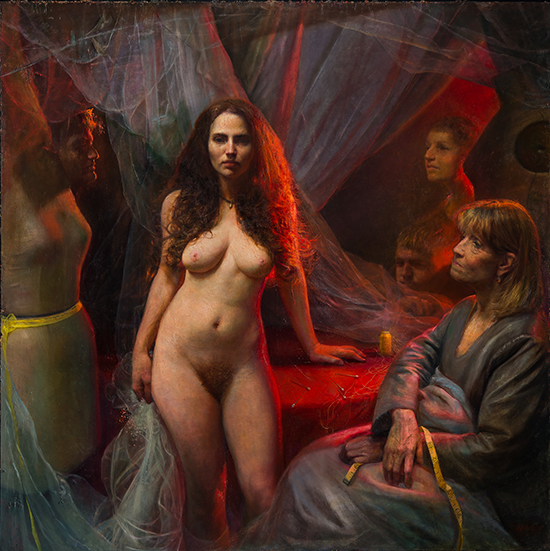
"Bridal Preparation" by Steven Assael, 2015. Oil on canvas, 68 x 68 inches. © Steven Assael, Courtesy of Forum Gallery, New York.
.
Symbols abound: a measuring tape, a mannequin, dressmaker pins pointing ominously to the exposed flesh of the bride. The seated older woman folds her arms across a gathering of cloth on her lap, an intimation perhaps of her womb, with a measuring tape entwined in her hands. Indicative of complex thoughts and feelings upon seeing a daughter prepare for marriage, the work is both poignant and restrained.
What doesn’t work so well is the 17th century gloom applied uniformly to all the paintings. Better suited to dramatic effect, its overuse grows a bit wearisome. Though effective in creating atmosphere, in a less dramatic picture it reads more like a historical affectation. For example, Seated Bride Holding Veil, ostensibly part of the bride series, is in fact a very traditional nude in the vein of Ingres’s Valpinçon Bather (1808). Based as it is on a specific classical model that calls for a level of subtle paint handling (that is certainly delivered) the paint handling itself becomes the subject, nudging the bride theme aside.
.
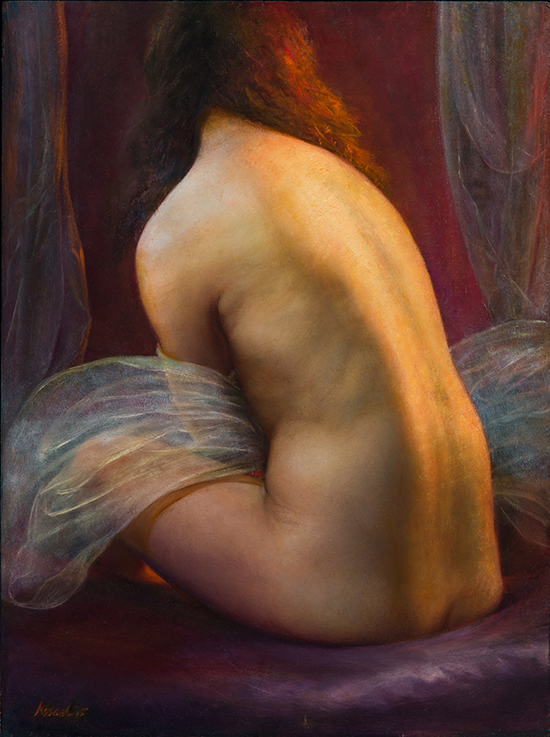
"Seated Bride Holding Veil" by Steven Assael, 2015. oil on board, 23 3/4 x 17 3/4 inches. © Steven Assael, Courtesy of Forum Gallery, New York.
.
Other indications of Assael’s extraordinary skill may be found in examples of his drawing in the show. Alansa is a tour de force of tonal blending and line control in which Assael proves himself a gifted, imaginative and consummate draftsman. The drawings also indicate full control of the expanse of untouched white paper that heightens the graphic quality of each sheet.
.
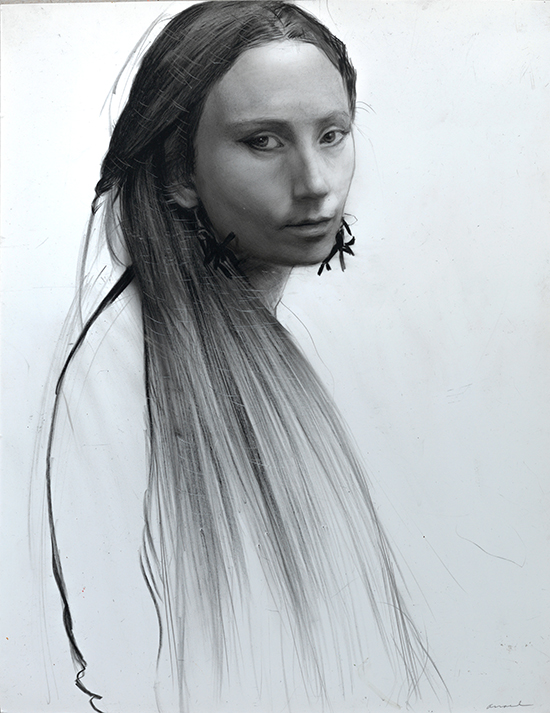
"Alansa" by Steven Assael, 2015. Crayon with graphite on paper, 14 x 11 inches. © Steven Assael, Courtesy of Forum Gallery, New York.
.
Juggling historical motifs, figurative rendering and dramatic content is a task better described as keeping several melons in the air, as opposed to mere tennis balls. In all fairness, Assael cannot be expected to dazzle on all fronts. Like Vincent Desiderio, Sharon Sprung or Eric Fischl, his ambition leaves him more vulnerable to missteps than a painter who works in a safe environment. An example in the latter category would be John Currin, whose freewheeling use of historical tropes would render him vulnerable were it not for the armor of sarcasm and mockery he wears.
Truly ambitious, humanistic representational painting is not for the faint of heart. Not unrelated to an artist who understands he is playing a very long game in an art world overtaken with fashion and ephemeral sparks, Assael is, and has been an enthusiastic teacher at Pratt, SVA and the New York Academy Graduate School, and in his own studio. One can only hope he is a long way from exhausting the inspiration that drives him.
___________________________
BASIC FACTS: “Steven Assael: New Paintings and Drawings,” remains on view through December 31, 2015. Forum Gallery is located at 2nd floor, 730 Fifth Avenue, New York, NY 10019. 212.355.4545, www.forumgallery.com.
____________________________
Peter Malone is an artist, painter, retired college gallery director and sometimes independent curator. A graduate of The School of Visual Arts and Teachers College, Columbia, Malone's reviews and essays appear in Artcritical, Painters on Painting and other publications. A recent recipient of a Pollock-Krasner Foundation Grant, Malone's work has been the subject of solo exhibitions at Blue Mountain Gallery and the Painting Center. He's currently working on an extensive series of portraits begun in 2013.
____________________________
Copyright 2015 Hamptons Art Hub LLC. All rights reserved.
